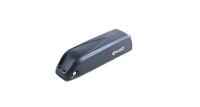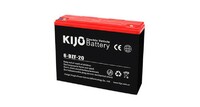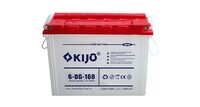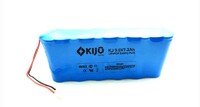FLOODED LEAD ACID BATTERY
Specifications
Types of Flooded Lead Acid Batteries
There are many types of flooded lead-acid batteries, which are used in photovoltaic energy storage systems. There are three types that are mostly used: flooded lead-acid batteries, valve-regulated
lead-acid sealed batteries, and lead-carbon batteries.
Flooded type Lead-acid Battery
The sulfuric acid in the electrolyte of flooded type lead acid battery directly participates in the battery charging and discharging reaction process. In traditional lead-acid batteries, the
remaining space in the battery jar, except for the polar plates, separators and other solid assembly parts is completely filled with sulfuric acid electrolyte, which is deep cycle flooded wet lead
acid battery, in which the electrolyte is in a state of excess, so it is called a "flooded" battery with the battery polar plates completely immersed in the sulfuric acid electrolyte. There is a
cover on the top of the flooded type lead acid battery that can ventilate and prevent the liquid from splashing. During use, due to the evaporation and decomposition loss of water, the cover needs
to be opened regularly to add distilled water and adjust the electrolyte density, so it is customarily called "open type" battery. The flooded type lead acid battery has the characteristics of
high power conversion efficiency, long cycle life, high terminal voltage, strong safety, high cost performance, simple installation and maintenance, etc. It is currently the preferred chemical
power supply in various energy storage, emergency system battery, and start-up devices.
Valve-regulated Lead-acid Sealed Batteries(VRLA batteries)
They are also known as maintenance-free batteries, which can be divided into two types: AGM lead-acid batteries and gel-sealed lead-acid batteries. The AGM battery uses pure sulfuric acid aqueous
solution as the electrolyte, most of which is in the glass fiber membrane, and a part of the electrolyte is absorbed inside the polar plate. AGM sealed lead batteries have less electrolyte, thicker
polar plates, and lower active material utilization than open-ended batteries, so the discharge capacity of the battery is about 10% lower than that of open-ended batteries. Compared with today's
gel-sealed batteries, AGM sealed lead batteries have a smaller discharge capacity. Gel-sealed lead storage battery (ie GEL type battery) and gel lead-acid battery are improvements of the ordinary
lead-acid battery with liquid electrolyte. It replaces the sulfuric acid electrolyte with the gel electrolyte, which improves the safety, storage capacity, discharge performance and service life
when compared with ordinary batteries. Its electrolyte is made of silica sol and sulfuric acid. The concentration of the sulfuric acid solution is lower than that of absorbent glass mat battery,
and the amount of electrolyte is more than that of absorbent glass mat battery, which is equivalent to flooded batteries. This electrolyte exists in a gel state and is filled in the separator and
between the positive and negative electrodes. The sulfuric acid electrolyte is surrounded by gel and will not flow out of the battery.
Lead-carbon Batteries
It is a capacitive lead-acid battery, which is a technology evolved from the traditional lead-acid battery. It adds activated carbon to the negative electrode of the lead-acid battery, which is a
flooded lead acid battery for solar power, and it can significantly improve the lifetime of lead-acid batteries. Lead-carbon batteries are the most advanced technology in the field of flooded
lead-acid batteries, and they are also the development focus of the international energy storage industry for new energy, and have very broad application prospects.They are widely used in energy
storage fields such as photovoltaic power station energy storage, wind power energy storage and grid peak shaving.
Different Voltages of The Flooded Lead-acid Batteries
When the flooded lead-acid battery is discharged, the metal lead is the negative electrode, which occurs the oxidation reaction and produces lead sulfate; the lead dioxide is the positive
electrode, and the reduction reaction occurs to produce lead sulfate. When the battery is charged with direct current, elemental lead and lead dioxide are generated at the two poles respectively.
After removing the power source, it returns to the state before discharge to form a chemical battery. Lead batteries can be charged and discharged repeatedly, whose single voltage is 2V. The
battery is a battery pack composed of one or more cells, referred to as storage battery. The most common ones are 6v flooded lead acid batteries, 8v flooded lead acid batteries, and 12v flooded
lead-acid battery, and there are other 2 volt flooded lead acid battery, 4V, 24V batteries.
The charging and discharging current of the battery are related to the system. If it is not designed well, it will affect the performance of the system. Shallow cycle discharge helps to extend
flooded lead acid battery life. The shallow cycle operation of the battery has two obvious advantages: first, the battery generally has a longer cycle life; second, the battery often retains more
spare ampere-hour capacity, so that the power supply guarantee rate of the photovoltaic system is higher. According to actual operating experience, the moderate depth of discharge is 60% to 70%.
KIJO is a leading flooded lead acid battery supplier/manufacturer/company in China, please contact us!
KIJO battery Group is one of the most professional storage battery suppliers and vrla battery suppliers, we provide motive battery, ups power supply battery, front terminal battery and etc. Want to
know more about industrial lead acid battery marker? Please contact us.
- Country: China (Mainland)
- Address: 1388 Fushan No.1 Street,Xiaolan Economic Development Zone, Nanchang, Jiangxi, China
- Contact: Jason Chuang










